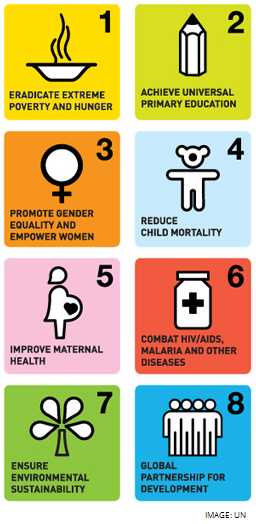BY KRISTA HENDRY
As we approach the last 500 days to meet the Millennium Development Goals (MDGs), I want to reflect upon what they actually mean for our work at The Fund for Peace. Our mission is to understand the underlying conditions of conflict in order to build practical solutions to address them with all actors, as well as measure our combined successes and failures in doing that. The MDGs have provided development actors, politicians, and many others with targets on issues that we often identify as putting pressure on a country and its citizens. If these are left unaddressed, they often lead to conflict, either within communities, across communities, or even against the state itself. Poverty and lack of access to education and healthcare services are among the issues that have been identified, as is environmental sustainability, all of which we measure in our annual Fragile States Index (FSI).
 The MDGs focus on bringing improved and sustainable livelihoods to the world’s most marginalized and vulnerable populations. They have focused on trying to ensure relevant and measurable impacts are anchored within the larger framework of state stability, not just the creation of quick interventions and one-off programs. This has meant that not only are development actors delivering services, but also that political decisions have had to be made and state institutions developed in order to successfully address identified issues that are hampering development and potentially fueling conflict. One of the most difficult things about working in the peace and security field is that we know that change can take many generations to occur and measurable sustainability even longer. Yet we all want to see that our work is making a difference and having an impact. The MDGs allow us to look longer term, instead of having the more short-sighted, quick-impact focus that emergency development work entails. Yet they can also demonstrate short and medium-term impact, which is crucial because of our desire to help people and alleviate suffering now.
The MDGs focus on bringing improved and sustainable livelihoods to the world’s most marginalized and vulnerable populations. They have focused on trying to ensure relevant and measurable impacts are anchored within the larger framework of state stability, not just the creation of quick interventions and one-off programs. This has meant that not only are development actors delivering services, but also that political decisions have had to be made and state institutions developed in order to successfully address identified issues that are hampering development and potentially fueling conflict. One of the most difficult things about working in the peace and security field is that we know that change can take many generations to occur and measurable sustainability even longer. Yet we all want to see that our work is making a difference and having an impact. The MDGs allow us to look longer term, instead of having the more short-sighted, quick-impact focus that emergency development work entails. Yet they can also demonstrate short and medium-term impact, which is crucial because of our desire to help people and alleviate suffering now.
Progress in some places and lack of progress in others on the MDGs can be seen when we review the trends of the countries we include in the FSI. This year marked the 10th anniversary of the FSI. Looking over the decade, we have a few unexpected stories of success, including in countries where we have worked with partners to help better understand issues on the ground and inform those working on programs to address them. And while this change has often been slow, at least sometimes, as the tortoise said, slow and steady wins the race.
One of the 2014 FSI’s most improved countries, Liberia, provides a clear demonstration of how the MDGs can play a crucial role in bringing a post-conflict country back from the brink. Liberia also happens to be a country that FFP is intimately familiar with, having operated a successful project aimed at engaging civil society in conflict early warning and mitigation from 2007 to 2014.
Liberia, after two decades of nearly non-stop war, presented a monumental challenge to even the most ambitious investors in its future. Indeed, many both inside and outside of the development community saw Liberia as a lost cause, or at least a generational uphill slog to secure even minimum progress. Despite these challenges, Liberia has pulled itself back from the brink and indeed is in many ways thriving. With targeted investment on the part of the MCC in partnership with the government of Liberia into improving girls’ education, increasing access to land and land rights, and improving Liberia’s trade policies, the country has made significant gains. Most importantly, from our perspective, these gains can not only be measured at the national level, but can be seen directly at the local, community level where our project operated.
Throughout the country, Liberia continued to make obvious and measurable gains in ensuring access of the majority of its population, especially girls, to free primary education. The number of women and girls who participated in our project, even in the most remote areas, was a testament to how such policies had successfully trickled down over time. Also in the areas of land access and land rights, two of the most vexing problems facing post-conflict Liberia, the level of awareness of both governmental policies and citizen’s rights was notable, even if the topic was still very controversial. Of course, Liberia has also benefited from strong leadership and a president who prioritized these key issues as main pillars of her national policies. For us, however, the key sign of successful, targeted investments in specific sectors for development remains that we saw it at the grassroots level. Everyday citizens were benefiting from the work of the MDGs, without even realizing that there was this international initiative helping to support the activities of government and others.
Overall, the MDGs are one tool in the larger toolkit of strategies to successfully address some of the world’s most vexing and entrenched issues that often hold countries back at the cost of their citizens. They have, in cases like Liberia and many others, demonstrated the utility and practicality of targeted, longer-term interventions meant to encourage a broader change in policy and behavior leading to human security and sustainability. And sustainable societies, for us as well as those who designed the MDGs, are the ultimate objective.
